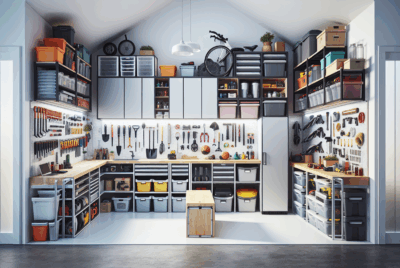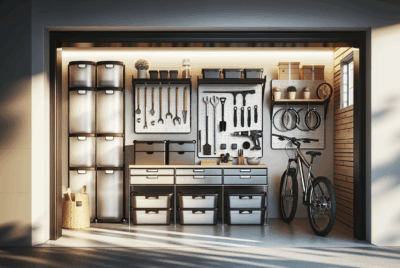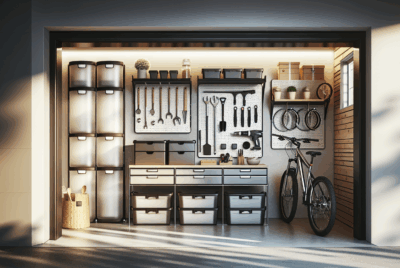Eco-Friendly Garage Organization: Sustainable Tips for a Greener Space
As an Amazon Associate, I earn from qualifying purchases, at no additional cost to you. Disclaimer
Organizing a garage in an eco-friendly way can make a big difference. It reduces the energy used in your home, helps the environment, and even saves you money.
Using sustainable materials and focusing on energy efficiency can lower your carbon footprint. This ensures that your garage not only stays clean but also becomes part of a greener planet.

I started by looking at ways to use less energy in my garage. Adding insulation and energy-efficient lighting was key.
This kept the space comfortable in all seasons without cranking up the heating or cooling. I also found that repurposing old shelves and using recycled materials helped cut down on waste.
Choosing eco-friendly storage solutions was another important step. I focused on materials that were durable and made from recycled or renewable resources. This approach ensured that my garage looked great and stayed organized, all while being kind to the planet.
The Importance of Eco-Friendly Garage Organization

An eco-friendly garage helps reduce energy use and lowers carbon footprints. Organizing your garage with green principles in mind brings order and protects the environment.
Understanding Your Carbon Footprint in the Garage
In my garage, simple actions can significantly impact the environment. For example, using energy-efficient lighting decreases energy consumption.
Switching to LED bulbs reduces electricity use, which is good for the planet. I notice that unplugging tools when not in use further cuts down energy waste.
Another area of concern is the materials I choose. By selecting sustainable options for shelves and storage, I help reduce my carbon footprint. For instance, recycled materials and reclaimed wood are better choices.
Even my vehicle maintenance can contribute. Proper tire inflation and regular tune-ups lead to less fuel consumption. Each of these steps, while small, adds up to a more eco-friendly garage.
Benefits of an Organized, Eco-Friendly Garage
A well-organized eco-friendly garage provides many advantages. First, I find things easily, saving time and reducing stress. An organized space means fewer misplaced tools and equipment.
Additionally, organization leads to better use of space. Storing items properly keeps them in good condition, which means I buy replacements less often. This reduces waste and saves resources. Using bins made from recycled materials adds another layer of environmental protection.
There are also health benefits. Reducing clutter improves air flow and reduces dust collection, creating a healthier atmosphere. Lastly, an orderly, green garage can increase home value. Buyers appreciate eco-friendly homes. Embracing eco-friendly principles in my garage leads to a cleaner and more sustainable lifestyle.
First Steps to Eco-Friendly Garage Organization

Before organizing my garage, I need to know what’s there and decide what’s essential and sustainable. Focusing on eco-friendly methods helps in creating better garage storage solutions while utilizing space efficiently.
Assessing Your Current Garage Setup
I start by taking a close look at what’s inside my garage. I need to know how much space I have and what’s filling it up. This means checking shelves, corners, and the floor for anything that’s cluttering my space.
I make a list of all items, both big and small. This helps me figure out what I use often, what I rarely touch, and what’s just taking up space. Knowing these details makes it easier to plan my garage storage solutions.
Then, I think about safety. I make sure items like paint and chemicals are stored properly. If I find something that’s old or broken, it’s time to recycle or dispose of it responsibly. Planning the layout keeps everything organized, making my garage safe and efficient.
Decluttering with Sustainability in Mind
When decluttering, I focus on eco-friendly ways to reduce waste. I begin by sorting items into three categories: keep, donate, and recycle.
Donating useful things means they find a new home instead of ending up in a landfill. For items that can’t be donated, I look for recycling centers that handle specific materials like metals, plastics, and electronics.
Recycling prevents waste and is a key part of sustainable living. I keep an eye on what’s reusable. Repairing or repurposing items can give them a second life.
Finally, I consider storage systems that maximize space and use eco-friendly materials.
Efficient use of space involves organizing tools on wall-mounted racks or installing shelves with recycled materials. This ensures that my garage stays tidy while also being gentle on the planet.
Designing Your Eco-Friendly Garage Layout
To design an eco-friendly garage layout, I focus on maximizing vertical space while making efficient use of the available area. These strategies help organize the garage effectively and sustainably.
Maximizing Vertical Space
Using the vertical space in the garage can increase storage capacity without wasting floor space. I install tall shelving units that go up to the ceiling. These units are great for storing infrequently used items, keeping them out of sight but within reach.
I also use wall hooks and pegboards for hanging tools, gardening equipment, and even bicycles. This keeps the floors clear and makes tools easy to find. I select adjustable systems that can change as my needs evolve.
Another idea is to add overhead storage racks. These are perfect for bulky items like camping gear or seasonal decorations. Ensuring these racks are secure is important to prevent accidents. Using vertical space wisely can make a small garage feel much more spacious.
The Role of Efficient Space Utilization
Efficient space utilization means organizing the garage to make every inch count. I start by sorting through items and deciding what to keep, donate, or recycle. This reduces clutter and makes the garage more functional.
Drawer units and cabinets with compartmentalized storage help keep small items neat. I label everything, so items are easy to find when needed.
Using multi-functional furniture like workbenches with built-in storage is also very useful.
I place frequently used items within easy reach, while lesser-used ones get stored higher up. This approach saves time and reduces the energy spent searching for things. Proper space utilization makes maintaining an organized, eco-friendly garage much simpler.
Choosing Sustainable Storage Solutions

When organizing a garage, picking sustainable storage is key. Using eco-friendly materials and systems can make a big difference. I’ll guide you through the best sustainable choices available.
Sustainable Materials for Garage Storage
Choosing materials that are good for the planet is essential. Bamboo is a smart pick. It’s strong and grows quickly. Recycled metal shelves can also be sturdy and long-lasting.
Wood from sustainable forests offers a classic look without harming the environment. Look for those with certifications like FSC (Forest Stewardship Council) to ensure sustainability.
Consider using recycled plastic bins. They reduce waste and can last a long time. Opting for these materials lets me keep my storage green and efficient.
Eco-Friendly Storage Systems Overview
An eco-friendly system combines effective use of space with sustainability. Modular systems are great because they’re adaptable. You can rearrange them without buying new pieces, which saves resources.
Wall-mounted racks help maximize space without cluttering the floor. They can be made from sustainable materials like metal or wood. Overhead storage is another option that keeps the floor clear and uses often-overlooked space.
Some systems feature adjustable parts, making them versatile and reducing the need for new purchases. By choosing these systems, my garage stays organized and easy to navigate.
Implementing Green Practices in Your Garage
I can save energy and reduce waste by making a few changes in my garage. Using energy-efficient lighting and keeping up with regular maintenance are two good ways to start.
Energy-Saving Lighting Options
Switching to LED bulbs can make a big difference. These bulbs use less energy and last longer than traditional ones. This helps me cut down on electricity bills and reduces my carbon footprint.
Installing motion sensor lights is another great idea. These lights turn on only when there is movement in the garage. This means I don’t have to worry about wasting energy when I’m not in there.
It is also possible to improve natural lighting whenever possible. This could mean adding windows or using light tubes to bring in sunlight. Natural light cuts down on the need for artificial lighting, which saves energy.
Regular Maintenance for Energy Efficiency
Regular maintenance ensures that my garage equipment and systems run smoothly. Inspecting the insulation in walls and doors can prevent heat loss. This keeps the temperature stable, reducing the need for extra heating or cooling.
I should also check my garage door seals. Good seals stop drafts and keep the space more energy-efficient. Looking over HVAC systems, if any, can also make sure they are working properly and efficiently.
By keeping everything in top shape, I can make sure my garage is as energy-efficient as possible. It helps me avoid energy waste and ensures equipment lasts longer.
Innovative DIY Garage Organization Ideas
Organizing a garage can be both practical and eco-friendly. By building custom workbenches and using upcycled materials, I can utilize storage solutions that are sustainable and fit my needs.
Building a DIY Workbench
Creating a DIY workbench in the garage can make it a workspace for various projects. To start, I’ll pick simple, sturdy materials like reclaimed wood or recycled metal, which are both cost-effective and eco-friendly.
I might consider a folding workbench for a space-saving option. This can be mounted to the wall and folded down when needed. I’ll add hooks or pegboards nearby for tools to keep them within reach while maximizing storage options.
Upcycling for Garage Storage
Upcycling turns old items into useful storage. I’ll go through my home and find unused items like shelves, bins, or jars that can be repurposed. For example, old wooden crates can serve as shelves for storing tools or gardening supplies.
I’ll use pegboards to create adjustable storage for smaller tools or accessories. This way, everything has its place, reducing clutter. Painting or staining these reused materials gives a fresh look and helps match the garage’s theme, proving that storage solutions can be both functional and stylish.
Storage Accessories for Optimization
To keep a garage tidy and eco-friendly, it’s essential to use storage tools effectively. I focus on pegboards, hooks, custom cabinets, and shelving for smart organization.
Pegboards and Hooks
Pegboards are versatile for organizing tools.
I use pegboards to keep items visible and easy to reach.
With the help of various hooks, it’s simple to hang tools, sports gear, and even small power tools.
Bike hooks and peg rails expand the pegboard’s usefulness, helping to store bikes vertically. This saves ground space and keeps things off the floor.
Hooks come in many shapes to fit everything, from hammers to gardening tools, providing a neat and accessible environment.
Custom Cabinets and Shelving
For a more tailored solution, custom cabinets are helpful.
These offer plenty of storage for all sorts of items. Whether it’s small bits and bolts or larger tools, cabinets keep everything organized and dust-free.
Wall-mounted shelving is another excellent option to optimize space.
By placing shelves high, I maximize floor space for ease of movement.
There’s room for heavy items and gardening supplies, all neatly tucked away. This system keeps the garage looking clean while maximizing efficiency.
Labeling and Organization Systems
An eco-friendly garage organization relies on clear labeling and effective organization systems.
Methods for Labeling and Categorization
I focus on using recycled materials for labels.
Old cardboard or reused jars work well. I cut them into shapes and write on them with non-toxic markers.
For even more durability, I consider laminated labels, which resist water and dirt.
When it comes to categorizing, I use clear, descriptive words.
Words like “tools,” “sports gear,” and “seasonal decorations” help me quickly locate items.
Color-coding with eco-friendly paints or stickers is another method I find helpful.
For instance, green labels for garden supplies and blue for tools create a visual system I can understand at a glance.
A detailed inventory list on a recycled notebook or digital app keeps track of everything. This list includes the location of each item, ensuring I know where everything is stored.
Maintaining an Organized Garage
Consistency in putting items back is crucial.
After using something, I make sure it returns to its labeled spot. This prevents new clutter from forming.
I also schedule regular “tidy-up” sessions to keep everything in order.
Using garage cabinet systems helps me contain clutter.
Cabinets built from sustainable materials provide a lasting solution.
I like having dedicated sections inside the cabinets for different categories, with shelves or hooks for vertical use. This maximizes available space.
I incorporate storage ideas like overhead racks to free up floor space.
Wall-mounted pegboards are perfect for hanging frequently used items. These systems not only save space but also maintain neatness and accessibility.
Creating Multi-functional Garage Spaces
When organizing a garage, combining storage with work areas and using overhead and wall-mounted options can maximize space. These strategies create multi-functional spaces that are both efficient and eco-friendly.
Combining Storage and Workspace Areas
I start by blending storage with work areas to make the most of my garage space.
Workbenches with built-in storage keep tools and materials organized.
I choose benches with drawers and shelves to save space. Multipurpose furniture like foldable tables can expand or store away as needed.
Pegboards are a great addition. I use them to hang tools and equipment. This keeps the work area neat and tools within reach.
Cabinets and bins help store smaller items. I label everything for easy access and organization.
Overhead Storage and Wall-Mounted Options
To maximize space, I utilize overhead storage.
Installing ceiling racks helps me store items like storage bins and seasonal gear. This keeps the floor clear and free of clutter.
Bike hooks are also handy for hanging bicycles overhead.
I also install wall-mounted shelves. They provide a spot for larger items that don’t fit overhead.
These shelves make it easy to store everything from paint cans to larger tools. Using wall space allows for future expansion with additional wall units or hooks.
Frequently Asked Questions
I often get questions about eco-friendly ways to organize a garage. People want to know about materials, repurposing ideas, waste reduction, eco-friendly brands, maintenance tips, and responsible disposal methods.
What are some sustainable materials to use for garage shelving and cabinets?
For shelving and cabinets, I recommend using bamboo or reclaimed wood. Both are durable and sustainable. Recycled metal can also be a good choice. These materials not only reduce waste but can also add an aesthetic touch to your garage.
How can I repurpose items for organizing my garage in an environmentally friendly way?
I like turning old crates into storage bins. Glass jars make great containers for small items like screws and nails. Even broken furniture can be repurposed into unique storage solutions with a bit of creativity.
What are the best practices for minimizing waste when organizing a garage?
I always start by decluttering and sorting items into keep, donate, and recycle piles. This helps minimize what goes into the trash. Purchasing second-hand or upcycled items is another way to reduce waste while organizing.
Can you suggest any eco-friendly companies that specialize in garage organization products?
Some trusted names include The Container Store, which offers sustainable options. IKEA is also a great choice for affordable, eco-friendly storage items. Both companies prioritize sustainability in their products.
How do I maintain an eco-friendly garage organization system over time?
Regularly review and reorganize your garage.
I suggest using compostable or recyclable storage bins.
It’s also important to repair rather than replace damaged items—it helps reduce waste and conserve resources.
What are effective strategies for recycling and disposing of garage waste responsibly?
First, check local guidelines for recycling specific materials.
I recommend setting up different bins for metals, plastics, and hazardous waste like old paint.
Composting organic waste, when possible, is another good strategy.



